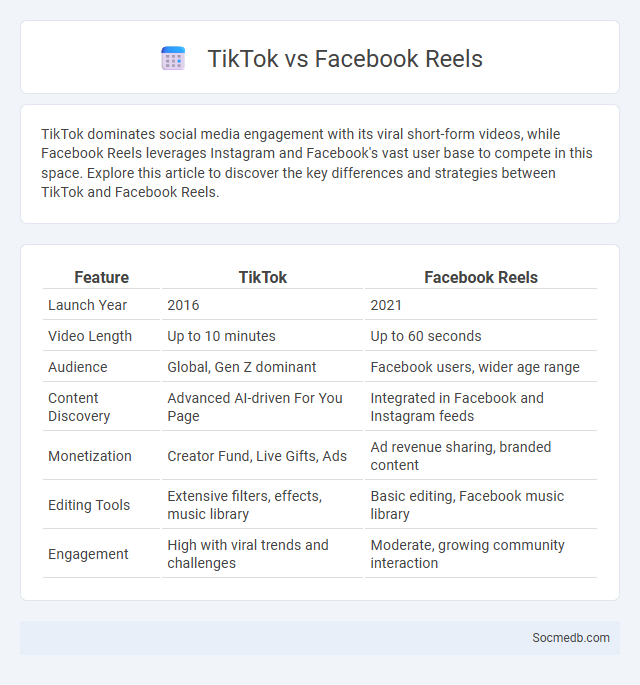
Photo illustration: TikTok vs Facebook Reels
TikTok dominates social media engagement with its viral short-form videos, while Facebook Reels leverages Instagram and Facebook's vast user base to compete in this space. Explore this article to discover the key differences and strategies between TikTok and Facebook Reels.
Table of Comparison
| Feature | TikTok | Facebook Reels |
|---|---|---|
| Launch Year | 2016 | 2021 |
| Video Length | Up to 10 minutes | Up to 60 seconds |
| Audience | Global, Gen Z dominant | Facebook users, wider age range |
| Content Discovery | Advanced AI-driven For You Page | Integrated in Facebook and Instagram feeds |
| Monetization | Creator Fund, Live Gifts, Ads | Ad revenue sharing, branded content |
| Editing Tools | Extensive filters, effects, music library | Basic editing, Facebook music library |
| Engagement | High with viral trends and challenges | Moderate, growing community interaction |
Introduction: The Battle of Short-Form Video Platforms
Short-form video platforms like TikTok, Instagram Reels, and YouTube Shorts dominate social media engagement with their rapid content consumption and viral potential. These platforms leverage advanced algorithms to optimize user retention and personalize content recommendations. Brands and creators compete fiercely to capture attention, driving innovations in video editing features and interactive tools.
TikTok Overview: Features and User Demographics
TikTok is a leading social media platform known for its short-form video content, offering features like video editing tools, sound integration, and algorithm-driven personalized feeds. Its user demographics primarily consist of Gen Z, with over 60% of users aged between 16 and 24, making it a hub for youth culture and trends. The platform's unique blend of creative expression and viral potential drives high user engagement and rapid content dissemination.
Facebook Reels Explained: Integration and Audience Reach
Facebook Reels seamlessly integrates with the main Facebook platform, allowing users to create and share short-form video content directly within their news feed and Stories. This feature leverages Facebook's vast user base of over 2.9 billion monthly active users to maximize audience reach and engagement. With powerful algorithms, Facebook Reels promotes personalized content discovery, boosting visibility for creators and brands across diverse demographics.
Content Creation: Tools and Trends Comparison
Content creation tools like Canva, Adobe Creative Cloud, and Final Cut Pro enhance your ability to produce visually appealing social media posts and videos efficiently. Emerging trends emphasize short-form video content on platforms such as TikTok and Instagram Reels, which drive higher engagement and reach targeted audiences effectively. Leveraging AI-powered editing software and analytics tools optimizes content quality and performance, ensuring your social media strategy stays ahead in a competitive landscape.
Algorithm Differences: How Content Goes Viral
Social media platforms use unique algorithms that determine how content spreads and goes viral, with factors such as engagement rate, user behavior, and content type playing crucial roles. For instance, TikTok's algorithm prioritizes short, engaging videos with high completion rates, while Instagram focuses on content interactions and recency. Understanding these algorithm differences helps you tailor your content strategy to maximize reach and viral potential.
Engagement Metrics: Likes, Shares, and Comments
Engagement metrics such as likes, shares, and comments serve as vital indicators of your social media content's effectiveness and reach. These interactions provide valuable insights into audience preferences, helping you tailor your strategy for maximum impact. Prioritizing content that boosts these metrics can significantly enhance your brand visibility and foster deeper connections with your followers.
Monetization Opportunities for Creators
Social media platforms offer a variety of monetization opportunities for creators, including sponsored content, merchandise sales, and subscription services like Patreon or OnlyFans. You can leverage analytics tools to target specific audiences and maximize revenue through ad placements and affiliate marketing. Diversifying income streams enhances financial stability and supports long-term growth in the creator economy.
Cross-Platform Promotion Strategies
Cross-platform promotion strategies leverage multiple social media channels such as Instagram, Facebook, Twitter, and LinkedIn to maximize brand visibility and audience engagement. Integrating consistent messaging and tailored content for each platform ensures your marketing efforts resonate effectively across diverse user demographics. Utilizing analytics tools helps optimize posting schedules and content formats, driving higher interaction rates and ROI for your campaigns.
Brand Marketing: Choosing the Right Platform
Selecting the right social media platform is crucial for effective brand marketing, as each platform caters to different demographics and content formats. Understanding where your target audience spends their time enables you to tailor your messaging and maximize engagement. Your brand's success depends on leveraging platform-specific features to enhance visibility and foster authentic connections.
Conclusion: Platform Strengths and Future Trends
Social media platforms exhibit unique strengths such as Facebook's extensive user base, Instagram's visual appeal, and TikTok's engaging short-form video content. Emerging trends indicate increased integration of AI-driven personalization, augmented reality features, and e-commerce capabilities to enhance user experience and monetization. Continued innovation and adaptation to data privacy regulations will shape the future landscape of social media ecosystems.
 socmedb.com
socmedb.com